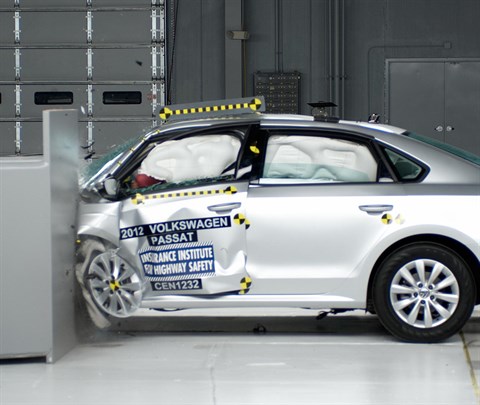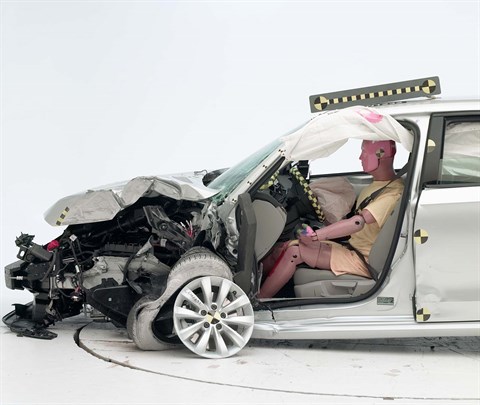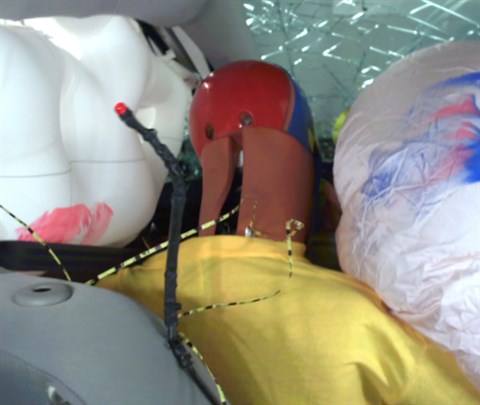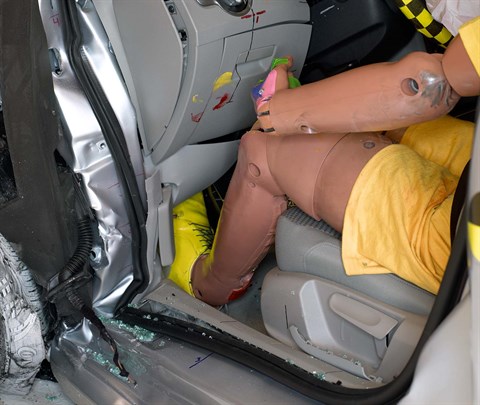Small overlap front: driver-side
Rating applies to 2013-15 models built after October 2012
Tested vehicle: 2012 Volkswagen Passat S 4-door
The Volkswagen Passat was redesigned for the 2012 model year. Beginning with 2013 models built after October 2012, the side curtain airbags were reprogrammed to deploy in small overlap frontal crashes to improve occupant protection. (Information about when a specific vehicle was manufactured is on the certification label typically affixed to the car on the driver door or adjacent B-pillar.) The tested car was retrofitted by Volkswagen engineers with a new airbag computer identical to that used in the modified production cars.
| Evaluation criteria | Rating |
|---|---|
| Structure and safety cage | |
| Driver injury measures | |
| Head/neck | |
| Chest | |
| Hip/thigh | |
| Lower leg/foot | |
|
Driver restraints and dummy kinematics
The dummy’s head barely contacted the frontal airbag before sliding off the left side as the steering column moved 12 cm to the right, leaving the head vulnerable to contact with forward side structure. Additionally, the seat belt allowed excessive forward excursion of the dummy’s head and torso. The side curtain airbag deployed but does not have sufficient forward coverage to protect the head from contact with forward side structure and outside objects. | |

Action shot taken during the small overlap frontal crash test.

The dummy's position in relation to the door frame, steering wheel, and instrument panel after the crash test indicates that the driver's survival space was maintained reasonably well.

During the crash, the dummy's head barely contacted the frontal airbag before sliding off to the left as the steering column moved to the right. The seat belt allowed the dummy to move too far forward, as is evident from the gap between the seat back and the dummy's torso. The side curtain airbag did not extend far enough forward toward the A-pillar.

Except for door hinge pillar deformation, intrusion into the driver's space was reasonably well controlled, and risk of injuries to the dummy's legs and feet was low.
Moderate overlap front: original test
Rating applies to 2012-22 models
Tested vehicle: 2012 Volkswagen Passat S 4-door
The Volkswagen Passat was redesigned for the 2012 model year. Moderate overlap frontal ratings are assigned by the Institute based on a test conducted by Volkswagen.
| Evaluation criteria | Rating |
|---|---|
| Overall evaluation | |
| Structure and safety cage | |
| Driver injury measures | |
| Head/neck | |
| Chest | |
| Leg/foot, left | |
| Leg/foot, right | |
| Driver restraints and dummy kinematics | |
Side: original test
Rating applies to 2012-22 models
Tested vehicle: 2012 Volkswagen Passat S 4-door with standard front and rear head curtain airbags and standard front seat-mounted torso airbags
The Volkswagen Passat was redesigned for the 2012 model year. Side ratings are assigned by the Institute based on a test conducted by Volkswagen.
| Evaluation criteria | Rating |
|---|---|
| Overall evaluation | |
| Structure and safety cage | |
| Driver injury measures | |
| Head/neck | |
| Torso | |
| Pelvis/leg | |
| Driver head protection | |
| Rear passenger injury measures | |
| Head/neck | |
| Torso | |
| Pelvis/leg | |
| Rear passenger head protection | |
Roof strength
Rating applies to 2012-22 models
Tested vehicle: 2012 Volkswagen Passat SE 4-door
| Overall evaluation | |
|---|---|
| Curb weight | 3,256 lbs |
| Peak force | 20,592 lbs |
| Strength-to-weight ratio | 6.32 |
Head restraints & seats
Seat type: Power leather seats
| Overall evaluation | |
|---|---|
| Dynamic rating | |
| Seat/head restraint geometry |
About the head restraint & seat test
Currently, IIHS tests apply only to front seats.
Child seat anchors
Rating applies to 2015-22 models
| Evaluation criteria | Rating |
|---|---|
| Overall evaluation | |
| Vehicle trim | SE |
| Seat type | leatherette |
This vehicle has 2 rear seating positions with complete child seat attachment (LATCH) hardware.
It has 1 additional seating position with a tether anchor only.
| Evaluation criteria | Rating |
|---|---|
| Overall evaluation | |
| Vehicle trim | SE |
| Seat type | leatherette |
| Rating icon | Rating |
|---|---|
| G | Good |
| A | Acceptable |
| M | Marginal |
| P | Poor |
| Seating positions that rely on borrowed lower anchors or have only a tether anchor available are not rated. | |
thether anchor symbol | Tether anchor |
lower anchor symbol | Lower anchors |
| Lower anchor(s) can be borrowed from adjacent positions(s) | |
| No hardware available |
Details by seating position
| Position | Rating |
|---|---|
| 1 | |
| Tether anchor | |
| easy-to-find location | |
| no other hardware could be confused for anchor | |
| Lower anchors | |
| not too deep in seat | |
| not too much force needed to attach | |
| easy to maneuver around anchors | |
| 2 | |
| Tether anchor | |
| easy-to-find location | |
| no other hardware could be confused for anchor | |
| Lower anchors | |
| none available | |
| 3 | |
| Tether anchor | |
| easy-to-find location | |
| no other hardware could be confused for anchor | |
| Lower anchors | |
| not too deep in seat | |
| not too much force needed to attach | |
| easy to maneuver around anchors |
